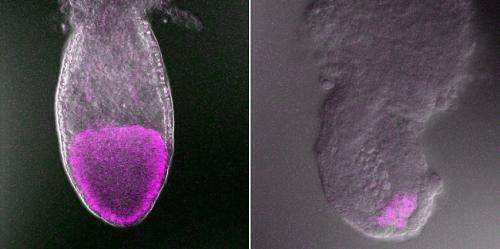Secrets of a t-haplotype gene revealed: Decade-long hunt turns up key gene involved in early mammalian development

The t haplotype in mice—a block of linked genes occupying the proximal half of mouse chromosome 17—is one of the best-studied examples of a selfish genetic element. Through an elaborate sperm-poisoning system, heterozygous males with only one copy of the t haplotype transfer the genetic element to over 95% of their progeny, while offspring that inherit two copies of the haplotype typically die during development.
This t haplotype is found in all subspecies of house mice around the world and is thought to have existed for more than 2 million years. Yet the lethal mutations contained within the complex that cause mice to perish in utero have eluded developmental geneticists for years. Now, after a decade-long search, scientists at the RIKEN BioResource Center have used positional cloning to discover the first one of these mutated genes—the gene responsible for the t5 allele. The findings reveal previously unknown developmental functions of this poorly characterized mammalian gene.
"I used to chat with my colleagues in the lab that cloning tw5 is like 'Waiting for Godot' [the Samuel Beckett play]; it may never come," says Kuniya Abe, who led the work. "But finally we found the tw5 gene."
Abe's team showed that the tw5 gene in mice is a homologue of one found in yeast that is involved in the trafficking of intracellular vesicles. When they deleted this gene, known as vacuolar protein sorting 52 (Vps52), they could recapitulate the hallmark tw5 phenotype in mice. Follow-up experiments showed that Vps52 is expressed in the visceral endoderm, a layer of cells that covers the very early-stage mouse embryo, and that Vps52 acts to support growth of the pluripotential embryonic ectoderm (Fig. 1). The researchers also found that Vps52 is involved in blood vessel formation (vasculogenesis) later in development, all through intricate cell–cell interactions.
"We could clearly show the gene is essential for at least two important developmental steps," Abe says. "We were intrigued by the results because a link between Vps52 and development was not expected."
Since mutations in Vps52 or in a related gene called Vps54 lead to defects in vasculogenesis, heart development and motor neuron degeneration, at least in mice, Abe suggests further exploration of the roles of these genes in cardiovascular and neurological diseases in humans should be pursued. "Elucidation of the Vps52 gene functions should provide insights into the etiology of these disease conditions, and eventually therapeutic applications as well," he says.
More information: Sugimoto, M. et al. Molecular identification of tw5: Vps52 promotes pluripotential cell differentiation through cell–cell interactions. Cell Reports 2, 1363–1374 (2012). dx.doi.org/10.1016/j.celrep.2012.10.004















